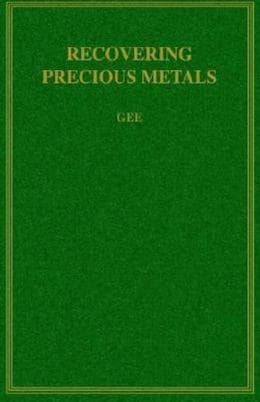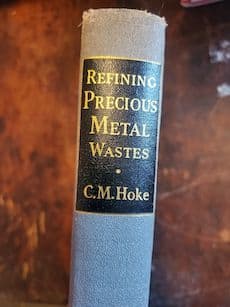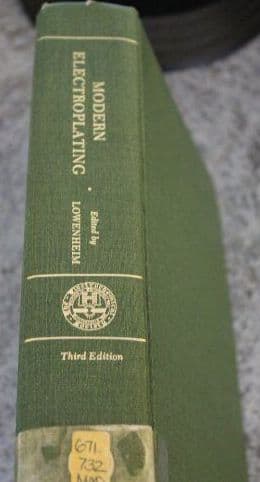
Curated with aloha by
Ted Mooney, P.E. RET

The authoritative public forum
for Metal Finishing 1989-2025

-----
Strip and recover silver from silver plated steel or stainless
Q. I have several dozen and probably more that I've misplaced.
What is the cost analysis of extracting the silver from the silverplated dishes, etc.
I guess bottom line is it worth it for someone to do this and what are approx. prices for supplies necessary.
Thank you so much!
student - Clive,Iowa
March 31, 2024

avail from eBay, AbeBooks, or Amazon

avail from eBay, AbeBooks, or Amazon

avail from eBay, AbeBooks, or Amazon

avail from eBay, AbeBooks, or Amazon

avail from eBay, AbeBooks, or Amazon
(as an Amazon Associate & eBay Partner, we earn from qualifying purchases)
A. Hi RJack
Chris Owen knows his stuff, and explains on this page basically what would need to be done.
Theoretically there could be electronic parts or other industrial components with a heavy enough layer of silver on an accessible enough substrate that silver recovery is practical. But your bottom line answer is that no one will give you a dime for silver plated trays, dishes, tea sets, etc., despite "We buy Gold. We buy Silver" stores on every other street corner in America, because no one can make money from it even with the collection mechanism already in place.
The recovery equipment can be built to any scale, even very small scale where the cost is not a hindrance. But the amount that needs to be learned can be a big impediment because cyanide is such a dangerous chemical. Household silverplate is unlikely to be plated onto steel or stainless steel; the substrate is likely either brass or 'nickel-silver' (the name comes from its purpose, nickel-silver does not contain any silver).
Luck & Regards,

Ted Mooney, P.E. RET
Striving to live Aloha
finishing.com - Pine Beach, New Jersey
⇩ Related postings, oldest first ⇩
Q. I am working in a electroplating company. we are doing silver plating also. we have some electroplated stainless steel and steel based material. now we want to extract the silver from the material. What is the best and easiest way to extract the silver? Thanking you.
Gandhi GovindarasuPlating shop employee - Singapore
November 10, 2011
A. Hi, Mr.Gandhi
You first treat your silver plated material in nitric acid which will dissolve your silver in nitric acid. Then by addition of NaCl or HCl you will get silver chloride; then reduce that AgCl using iron plates to get silver metal (cement silver).
- Mumbai, India
A. Using nitric acid, as explained in the post by Bhupesh Mulik, will work fine for stripping silver from most stainless steels. However, nitric acid will attack mild steel under many conditions, depending mainly on the steel alloy, the strength of the nitric, and the temperature of the solution. Once the steel starts dissolving, the reaction will generate much heat and it can become very uncontrollable.
A much better way to strip silver from mild steel is to use a cyanide based nickel stripper. It can also be used to strip the silver from the stainless. Using the immersion solution below, when the silver in the solution builds up to an economical point, it can be recovered by the addition of 325 mesh zinc dust
⇦ this on
eBay or
Amazon [affil links]
needed is about equal to the weight of silver in solution. It may take more if the sodium hydroxide (NaOH) content is high. You should use some NaOH (I would say at least 5-10 g/l) to prevent any possibility of the evolution of hydrogen cyanide gas (extremely toxic).
Immersion Solution from Modern Electroplating ⇨
Nitroaromatic compound (most use Ludigol = m-NBSS) - 60 g/l
Sodium Cyanide - 120 to 180 g/l
Sodium Hydroxide - 0 to 25 g/l
Temp - 60 to 75° C
sometimes on
AbeBooks or Amazon
(affil links)

free pdf is currently available from academia.edu
You can also use an electrolytic solution. The parts will have to be wired (steel wires), racked, or placed in a barrel plater. The silver should deposit on the cathode.
Electrolytic Solution from Metal Finishing Guidebook ⇨
Sodium Cyanide - 90 g/l
Sodium Hydroxide - 15 g/l
Room Temperature
Make parts anodic (+) at 2 to 6 volts
I would use stainless sheet cathodes (-)
- Nevada, Missouri, USA
Q. I have a large quantity of silver plated tableware from which I wish to remove the silver plate. The base metals will be variable, including brass, copper, nickel, and stainless steel. I've seen demonstrations on line using sodium chloride as an electrolyte. I wish to avoid the formation of silver chloride so I thought of using sodium hydroxide. I don't have a laboratory grade fume hood and don't wish to use any form of cyanide.
Dale DavisRetired Physics/Chemistry teacher, now a hobbyist. - Addison, Illinois
March 7, 2022
Q, A, or Comment on THIS thread -or- Start a NEW Thread
